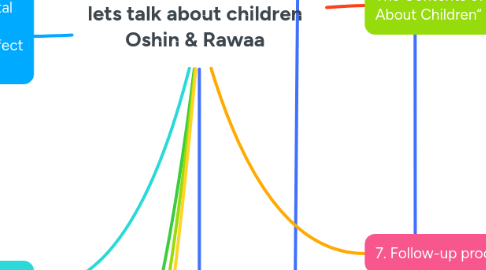
1. HOW TO TELL THE CHILDREN ABOUT MENTAL HEALTH PROBLEMS
1.1. rules
1.1.1. 1. simple language
1.1.2. 2.adequate explanations with rationales and examples
1.1.3. 3. assurance , discussion always include solution
1.1.4. 4.encourage to raise question, participate in decision making
2. factor supporting the children
2.1. communicate openly
3. RESPECTING THE PARENTS
3.1. free to decide ,will not be ordered around, pressurised or threatened
4. NEEDs FOR ADDITIONAL SUPPORT AND SERVICES
4.1. Network Meetings
4.1.1. children's resilience or flimsy social network and their Representatives talk, transfer the responsibility of care of children
4.2. Urgent Need for Child Welfare Services
4.2.1. Preventive or therapeutic interventions can never replace, immediately. Urgent child welfare needs refer here
4.3. Non-Cooperative Parents
4.3.1. parent is unable to talk about the children, child welfare authorities must be summoned.
5. Parental Mental Problems and How They Affect the Children
5.1. relationships between family members
5.1.1. affect one’s capability to show and feel empathy and sympathy for others
6. TOPICS FOR THE DISCUSSION
6.1. Children are not the reason for their parents' problems
6.1.1. parents clear confrontation about problems
6.2. Parents take care of themselves.
6.2.1. positivity of children, being thankful
6.3. Household Chores
6.3.1. equal work distribution
6.4. When the parent is easily irritated, and possibly violent
6.4.1. urgent child welfare actions
6.5. Divorce and suicide - the children's biggest fears
6.5.1. emphasise reason
6.6. The Child's Relationships with Other People
6.6.1. god parents, friends, trustworthy
7. supporting the development of children
7.1. professionals talk with family and parents and children to detect and help with problems
8. AIMS
8.1. Discussion, talk about the issues,
8.1.1. share thoughts
8.1.1.1. positive development in natural process
9. PREVENTATIVE SERVICES AND MENTAL HEALTH CARE SERVICES
9.1. methods do not include any kinds of treatment.
9.1.1. 1. to organise the parent's personal care. 2.parent should also be assessed and provided with proper care. 3. The Effective Family Network Meeting methods used.
10. Method
10.1. Intention
10.1.1. .Provide support in parenting and promote child development.
10.1.1.1. Assess the children's and family's need for additional support
10.1.1.1.1. Assess the need for child welfare and other social services
10.2. A structured but flexible method
10.2.1. Beardslee Family Talk Intervention is suggested, provided there are resources to carry out the intervention. Other alternatives include family workshops, and peer groups for the children and for the parents,
10.2.2. method is very flexible, and it is possible that one discussion session is enough, whereas in some cases there may be a need for more than two sessions,
10.3. Let’s Talk About Children“ Discussion
10.3.1. Are a creative and constructive method that will benefit both the children and the family as a whole. The important thing is that all topics are covered during the discussions
10.3.1.1. The Preliminary Discussion
10.3.1.1.1. „Let’s Talk About Children“ Discussions to the affected parent, and explaining what the method is about.
10.3.1.2. Discussion No 1
10.3.1.2.1. involves charting the developmental stage and overall situation of the children, together with the parent(s): to talk about the joys and concerns the parents have,
10.3.1.3. Discussion No 2
10.3.1.3.1. involves explaining how the parental mental health problems affect the family and children
10.3.1.4. The Effective Family Network Meeting
10.3.1.4.1. Representatives of the child's and the family's social networks, and of different supportive services, are invited to participate, The goal of it is to activate the people from the child's own social network to support the child together with the parents
10.4. 5. Available Tools
10.4.1. Volunteering professional expertise for the parents
10.4.2. Methodological files created by the KIDS STRENGTHS partnership regarding further information
10.4.3. Keeping the discussion on track ,important to keep the discussion focused on the children.
10.4.4. Leading the discussion back on track
10.5. 6.Charting the Child's Situation and Development
10.5.1. A) Assisting parents in identifying the strengths and vulnerabilities of their children
10.5.1.1. B) Joint discussions on why and how the parents could enhance the strengths of the children and help them overcome vulnerabilities both by themselves and by utilising additional support services
11. Effective family project
11.1. peer groups for both
11.1.1. family talk and meeting
11.1.1.1. researches development and implementation projects.
12. support child development
12.1. identify strengths, possibilities and protective factors.
12.2. adopting a new perspective on the work by health workers
13. The Contents of the „Let’s Talk About Children“ Discussions
13.1. A.What is the child's situation: define the terms "strength" and "vulnerability" in this context
13.1.1. What is the child's situation: define the terms "strength" and "vulnerability" in this context
13.1.1.1. What concerns do the parents have about the child and about the whole family
13.1.1.2. How does the child behave at home, in day care, at school, and during his or her spare time: friends, hobbies, media?
13.1.1.2.1. How does the child behave, and what is the child’s mood
